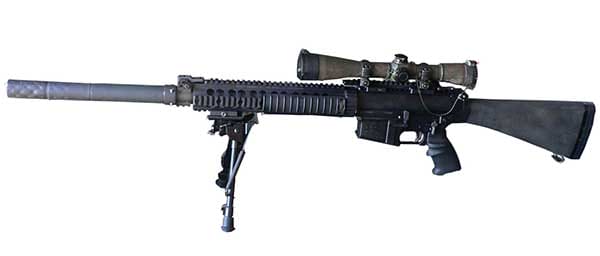1,200 Yards w/5.56 AR-15 – AXTS MI-T556 SPR Range Report

The
new AXTS SPR is a 5.56mm rifle designed for extreme long-range
shooting. The author was able to engage targets out to 1,286 yards
without missing a beat. Shown equipped with a Silencerco suppressor and
Atlas bi-pod.
The rifle is based on the Special Purpose Rifle (SPR) that was brought into U.S. military service as the MK12 in 2002. It was designed as an accurized version of the M16 chambered in 5.56mm. It used an 18” barrel designed to stabilize the heavier 77 grain bullets (MK262) for longer-range applications. Hand guards were free floated, tolerances a bit tighter, and iron sights more precise. Original models were equipped with a muzzle attachment that would accept a suppressor.

the
AXTS SPR delivers long-range 5.56mm performance. Engaging steel at
extreme distances, the AXTS SPR was stable and accurate, even when used
from improvised positions.
It’s not uncommon to see an SPR that will rival precision rifles for accuracy at ranges extending to 1,000 yards. Bullets are better, ammunition more effective and optics vastly improved. Whether you are a hunter, officer, target shooter, or just plain enthusiast, the SPR-style platform offers all you will ever need in a semi-auto rifle chambered in 5.56mm.
Long Range with the Mouse Gun?
For most of my career, “experts” have been telling me the .223/5.56mm is a 500-meter rifle, prevailing thought being it was ineffective beyond that range and lacked the accuracy necessary to get consistent hits any farther out. That may have been true in the 1980s when rifle and bullet technology was lacking. Given a rifle shooting into 4” at 100 yards on its best day and ammunition to match, 500 meters would be a stretch.Well, it’s not 1980 anymore, at least for a couple decades! Rifles today are different, shooters are better, and ammunition has improved by leaps and bounds. Factory rifles shoot twice as well as most early ARs. Purpose-built precision ARs can be astoundingly accurate. As to effectiveness, while many are willing to decry the 5.56mm’s limitations at “range,” few are willing to test them in person.
The terminal effectiveness of the new 77-grain TMK is substantially different than the FMJ of the day. It and similar bullets are proving devastating at ranges as far as 700 yards on small game. Accuracy potential on steel or paper reaches out to 1,000 yards given the correct combination. There is little doubt the sweet spot is the 100-700 yard range, but that is not the extent of its range. It’s a new world, and there are lots of new rifles to match.
Training at Range

The
author employed Spuhr’s ISMS mount. He feels it is super strong and
accommodates a number of accessories for long-range shooting.
While enlightening, it took some serious training with Buck Doyle from Follow Through Consulting to really open my eyes. Buck is a combat Marine with 22 years of service, much of it as a Force Recon Marine. Having used accurized ARs at range in combat gives him credibility. Several years of contracting afterwards added to his “been there done that” reputation. More importantly, he provided a means to learn how to do it yourself at his Scoped Carbine Class.
Held on his range at The Lodge at Red River Ranch in Teasdale, Utah, it’s a long-distance shooters dream. Targets are placed mostly from 300-1,100 meters amongst the beautiful red cliffs of Capitol Reef, Utah. It’s windy, dusty, and can be harsh, making it challenging. Targets are generally 12” circles with nothing bigger than a silhouette. Buck believes in “aim small, shoot small,” and practices that consistently.
Designed around a scoped 5.56mm carbine and the Horus TreMoR reticles, it’s all about ranging and getting on target fast. No knob turning; you use the reticle, and once dialed in you seldom see prone. It’s mostly from barricades, making the effectiveness of the SPR more surprising. It’s an eye opener. Having attended or assisted with several classes, students are hitting steel at 800 meters in stiff winds by day three. In at least a couple cases, students having never used an AR accomplish this. It rather quickly dispels any remaining mythology as to the ability of the 5.56mm cartridge to reach out.
AXTS MI-T556

Using just the Silencerco ASR flash hider, the AXTS SPR remains easy to maneuver, lightweight and well balanced.
Using one of my personal builds with an 18” barrel, the differences were obvious. Holds with the 77-grain TMK were often 10-20% less at the same range given muzzle velocities in the 2,750 feet per second range. It only proved what we both knew, that the 18” barrel was the ticket for taking complete advantage of modern ammunition without sacrificing usability. It prompted AXTS’s latest rifle based on Buck’s design input and extensive testing.
Buck Doyle’s dream AR, the SPR, was designed for practical application out to the limits of the 5.56mm cartridge. It started with an MI-T556, adding a few touches including a 17.5” barrel and full-length, custom hand guard to match. The results are impressive, to say the least.

The SPR features hand-fit, CNC-machined receivers. Controls are truly ambidextrous and the proper size for easy application.
For the SPR, a custom handguard using M-Lok is mated to the receiver ending just at the flash hider, covering most of the barrel. It protects the 17.5” barrel capped with a Silencerco ASR flash hider. Starting with a Shilen 416R blank, the barrels are profiled using a 1:8” twist rate. Each crown is hand polished. The highest quality barrel extensions are used with polished feed ramps and .223 Wylde chambers. An AXTS Black Nitrided bolt carrier group is utilized. Manufactured from case-hardened 8620 steel, the 4130 steel gas key is properly staked. The bolt is 9310 steel, MPI tested and CNC-ground following heat treatment for a perfect fit. It’s all coated in Black Nitride for the best possible operation under any condition. Charging is accomplished with an AXTS Raptor ambidextrous handle.

The rifle features an AR Gold trigger. Having a right-side bolt release makes reloads fast and keeps you locked into the gun.
SPECS
Chambering: .223 Wylde
Barrel: 17.5 Inches
OA Length: 34 inches (collapsed)
Weight: 6.5 pounds (bare rifle)
Sights: Optics rail
Stocks/Grips: Magpul MOE grip/AXTS M-Lok Hand Guard/Magpul STR Stock
Action: Semi-automatic/rotating bolt/gas impingement
Finish: Cerakote
Capacity: Accepts standard AR-15/M16 magazines
Price: $3,000
Finishing the Rifle Out
My Leupold Mark 6 3-18X scope using a Horus TreMoR 3 reticle was mounted in a Spuhr ISMS mount and covered with Adamount lens protection. It keeps the scope low to the rail. The built-in level keeps you square at range. A Trijicon RMR was added at one o’ clock using Spuhr’s mount. An Angle Cosign Indicator was attached to the left side of the mount, keeping everything compact and solid. SLR provided an M-Lok rail for the Atlas bi-pod. Dueck Defense offset sights were mounted for close quarters work. Testing was completed using the ASR along with Silencerco’s Omega .30-caliber suppressor.Accuracy

The
Shilen barrel really liked 77-grain bullets, including Remington’s
Premier Match. It produced this sub half-inch group at 100 yards.
 However,
that’s not where the accuracy story ends. Buck is fond of expressing
his lack of interest in what a rifle does at 100 yards. The real
question is will it hold that group at range, say 300 yards minimally,
even better 700 yards or more. Black Hills 69 grain TMK was a perfect
example. Struggling to shoot under .75 inches at 100 yards, it printed a
nice 5-inch group on 12 inch steel at 669 yards. Overall it created a
6-inch clump at that range over 10 rounds. Moving out to 887 yards, the
77-grain TMK and 77-grain Remington both held under 1 MOA vertically.
Even my group at 1,236 yards measured just over a foot vertically,
staying around that 1 MOA range. Bottom line, this rifle is about as
good as it gets in a semi and better than my capability most of the
time.
However,
that’s not where the accuracy story ends. Buck is fond of expressing
his lack of interest in what a rifle does at 100 yards. The real
question is will it hold that group at range, say 300 yards minimally,
even better 700 yards or more. Black Hills 69 grain TMK was a perfect
example. Struggling to shoot under .75 inches at 100 yards, it printed a
nice 5-inch group on 12 inch steel at 669 yards. Overall it created a
6-inch clump at that range over 10 rounds. Moving out to 887 yards, the
77-grain TMK and 77-grain Remington both held under 1 MOA vertically.
Even my group at 1,236 yards measured just over a foot vertically,
staying around that 1 MOA range. Bottom line, this rifle is about as
good as it gets in a semi and better than my capability most of the
time.Practical Application

The author found the AXTS SPR to be a true, long-range performer. This one can really reach out when needed.
With the Silencerco Omega installed it was easy to use under the truck, by the tires, or even next to the bumper. No concussion, minimal recoil, and plenty quiet for use without hearing protection. The MI-T556 remained balanced and the extended hand guard insured the barrel was never resting on cover. Using a GG&G barricade stop, it locked into barricades, trees, and the bench. Getting hits on 12 inch or smaller targets out to 400 was a no brainer; stretching it out to 800 took some solid wind reads, but this rifle is practical to 800 with ease and capable of hits at 1,000 with skill.
Other Considerations
Bullet impact shift was less than an inch when the suppressor was added, and was consistent. Return to zero was within half an inch when it was removed and reattached. Brass ejection was all but unaffected. With the suppressor attached or not it sent brass at roughly 4:00, just a bit farther with the suppressor. Gas in the face was almost unnoticeable, and over 100 rounds the magazine was still pretty clean. Given the lack of an adjustable gas block, this surprised me. It was pleasant enough that the Omega will stay on there for most training.Working inside the truck and shoot house took some work, but after 10 years running an 18.5” shotgun it’s not hard. Certainly not what its best at, but no worse than a 16” gun, and it will do things a 10” AR won’t. My conversion to this barrel length for a scoped carbine is complete and will not change. I like a short gun for dedicated work across the parking lot using a red dot sight; for everything else this rifle is the ticket. This may be Buck’s dream rifle, but we clearly share the same vision.
Final Thoughts
Retail on this SPR is in the 3K range, so you expect it to work. Still, the attention to detail is superb, rivaling only my hand-built custom rifles. Everything is smooth, mates perfectly, and operates flawlessly. Only the best possible parts are used, making mil-spec rifles look like toys. It’s like a custom 1911 that has been hand fit and contoured.This is the first production SPR off the line (not a prototype, but rather a full production model), but they are a few weeks out when it comes to ramping up the website to reflect the new product. AXTS prides themselves on a delivery time measured in weeks, not months, so give them a call to put in your order.
While you can certainly pay more you will not get much for it; it just does not get much better. At the same time it is a working rifle designed by a combat Marine with the sole purpose of using it, not hanging it in a safe. I test a lot of ARs, hundreds over the years. Nothing has come across my path any better, many less so at a higher cost. If you are in the market for a custom grade AR designed and tested for real world use this one needs to be at the top of your list, it may be your only choice!

A custom-made hand guard from AXTS locks up tight, providing one of the most solid ARs on the market.

Coated in Cerakote, the SPR is striking in certain light with a solid look that is useful in any environment.



















